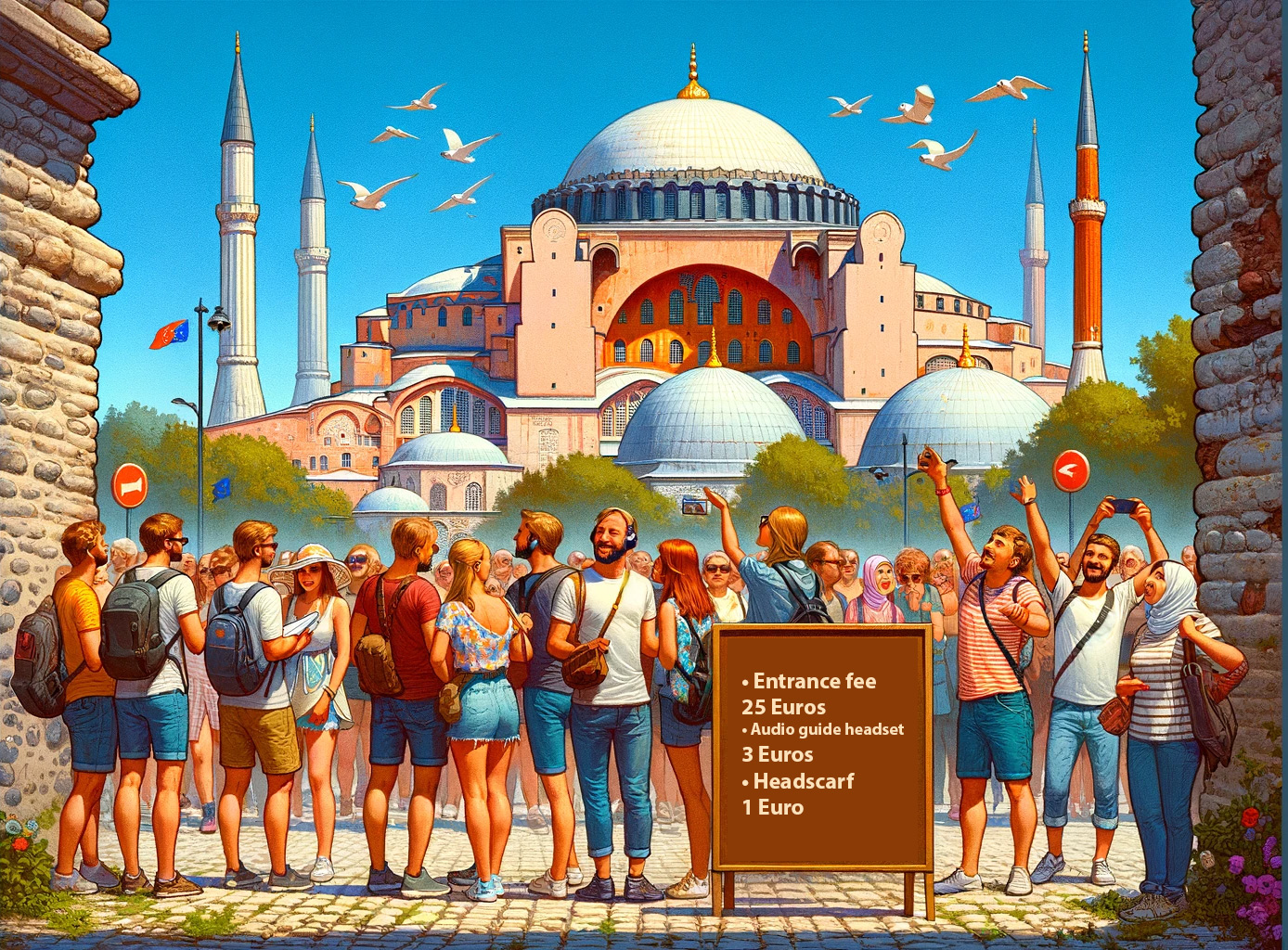Hagia Sophia has initiated a new entry policy for tourists. As of January 15, 2024, foreign tourists visiting the historic mosque for cultural purposes will be charged an entrance fee of 25 Euros. A ticket booth and entrance point have been established near the III. Ahmet Fountain. Tourists will be able to visit the gallery floor of the mosque, where they can view historical artifacts such as Byzantine-era mosaics. Additionally, information in 23 different languages will be available through a QR code system and headphones. This new arrangement does not apply to Turkish citizens visiting for prayer. The aim is to separate the entrances for cultural visitors and worshippers, thereby preventing long queues.
The Hagia Sophia has implemented a new entry policy. The locations for tourist entry have been changed and security measures enhanced, with the entrance fee for tourists now set at 25 euros.
The new regulation announced by the Ministry of Culture and Tourism has commenced at the Hagia Sophia Grand Mosque. The entrance fee for foreign tourists visiting the historical mosque for cultural purposes is now 25 Euros. From the early hours of the morning, foreign tourists formed queues at the ticket booths, while this regulation will not apply to Turkish citizens visiting the mosque for prayer.
The regulation previously announced by the Ministry of Culture and Tourism for the Hagia Sophia Grand Mosque came into effect on January 15. The new policy, aimed at separating those who come for worship from those visiting for cultural purposes and to alleviate congestion at the entrances, has set the visitation fee for foreign tourists to the historical structure at 25 Euros. A ticket booth and an entrance point have been positioned near the III. Ahmet Fountain for visitors.
It was learned that visitors to the Hagia Sophia Grand Mosque will be directed to the gallery floor through a tunnel and entrance ramp located under the II. Beyazid minaret on the south side, and exits will be facilitated through a ramp in the northeast direction. From the early morning hours, long queues of foreign tourists were seen at the ticket booths, where tickets, along with headphones and scarves, are being sold.
The Ministry of Culture and Tourism published a statement regarding the new application. The statement read, “The separation of those coming for prayer and those visiting the Hagia Sophia Grand Mosque for cultural purposes has been completed. As part of the restoration and preservation efforts initiated by the Minister of Culture and Tourism, Mehmet Ersoy, at Hagia Sophia, the gallery floor prepared for visitors will be open from January 15, located opposite the III. Ahmet Fountain. Protective measures along the tour route have been taken, and necessary security cameras, fire detection, and emergency announcement systems have been installed in the Hagia Sophia Grand Mosque. Cleaning and protection works on the marble cladding and wooden railings in the mosque’s gallery were conducted with the approval and consultancy of the Science Board by restorers and conservators. Minister Ersoy’s visitor management plan, previously announced to start at the Hagia Sophia Grand Mosque, will now prevent long queues from forming in the historical mosque.”
Information in 23 Languages
The statement continued, “Visitors to the Hagia Sophia Grand Mosque will be directed to the gallery floor through a controlled access tunnel and ramp located under the II. Beyazid minaret on the south side, with exits through a ramp in the northeast direction. Tourists reaching the gallery section will see the mosque’s prayer hall and Ottoman period additions, pass through the heaven-hell gate, and have the opportunity to examine the Byzantine period mosaics in this section. Starting January 15, the new policy at the Hagia Sophia Grand Mosque will allow tourists to visit without disturbing the prayer environment. With the QR code application and headsets, visitors can silently receive information in 23 languages without disturbing worshippers, using their own or provided disposable headphones. The entrance fee for foreign tourists visiting the historical mosque for touristic purposes will be 25 euros.
Introduction to Ayasofya
Ayasofya, also known as Hagia Sophia, stands as a magnificent testament to the rich history and cultural diversity of Istanbul. This architectural masterpiece, with its grand domes and intricate mosaics, has witnessed
centuries of transformations, bearing the marks of the Byzantine and Ottoman empires. As we delve into its fascinating history, we uncover the tales hidden within its walls and the significance it holds in the tapestry of world heritage.
The Early History of Ayasofya Originally built in the 6th century under the Byzantine Emperor Justinian I, Ayasofya was envisioned as an architectural marvel that would surpass all others. Its first incarnation set new standards in architectural design, with its massive dome and ornate decorations symbolizing the might and sophistication of the Byzantine era. This structure has been rebuilt several times due to various calamities, each reconstruction adding layers to its historical and architectural narrative.
Ayasofya Through the Ages Over the centuries, Ayasofya has stood as a silent witness to many pivotal historical events. It transitioned from a Byzantine church to an Ottoman mosque, and then into a secular museum in the 20th century, each phase reflecting the changing dynamics of the region. These transformations are not just in its function but also in its architectural and artistic embellishments, which blend Christian and Islamic influences.
The Architectural Splendor of Ayasofya Ayasofya’s architectural grandeur is a testament to the ingenuity of its creators. The central element, its massive dome, is considered an engineering marvel of its time, seemingly floating above the structure. The building’s design and construction techniques were revolutionary, setting a precedent for future religious and secular structures worldwide.
Cultural and Religious Significance The cultural and religious significance of Ayasofya is profound. For the Byzantines, it was a symbol of their Christian faith and imperial power. Under the Ottomans, it became a vital Islamic symbol and a testament to their architectural prowess. Today, it stands as a museum, embodying Turkey’s secular and diverse cultural heritage.
Art and Iconography in Ayasofya The interior of Ayasofya is adorned with stunning mosaics and frescoes, a harmonious blend of Christian and Islamic art. These artistic elements narrate stories from religious texts and depict figures significant to both faiths. The unique artistic features of Ayasofya make it a critical study in the evolution of religious art.
Ayasofya in Modern Times In recent times, Ayasofya has undergone extensive preservation efforts to maintain its structural integrity and artistic beauty. It plays a contemporary role as a symbol of historical pride and is a significant attraction for both locals and tourists, drawing millions of visitors each year who are eager to experience its majestic presence.
Tourist Attractions and Visitor Experience Visiting Ayasofya is like stepping into a historical narrative. Tourists can explore the vast nave, admire the intricate mosaics, and marvel at the architectural innovations. The site offers a unique experience that combines historical exploration with spiritual reflection.
Influence on World Architecture Ayasofya’s influence on world architecture cannot be overstated. Its innovative design, particularly the dome, inspired the construction of many other notable structures around the globe
, including the renowned Blue Mosque in Istanbul. The building serves as a benchmark in architectural history, showcasing how structural and aesthetic elements can be seamlessly integrated.
The Dome of Ayasofya: An Architectural Analysis The dome of Ayasofya, with its impressive diameter and height, has been a subject of admiration and study for centuries. Its engineering is a marvel, particularly considering the technological limitations of the time. The dome has undergone several restorations to address structural issues, each time reinforcing its resilience and enduring design.
Ayasofya in Literature and Popular Culture Ayasofya has captured the imagination of many writers and artists, featuring prominently in literature and various forms of media. It symbolizes a crossroads of cultures and histories, often used as a backdrop in storytelling to represent the confluence of East and West, past and present.
Controversies and Debates Surrounding Ayasofya The status of Ayasofya has been the center of various controversies and debates. Its transformation from a mosque to a museum and the recent discussions about restoring its religious status reflect the ongoing political and religious dynamics in Turkey and the broader global community.
Ayasofya’s Contribution to Turkish Culture Ayasofya is more than a historical monument; it is a symbol deeply ingrained in Turkish culture. It represents the rich tapestry of Turkey’s history, showcasing the nation’s ability to embrace and preserve diverse cultural influences.
Ayasofya’s Global Significance As a UNESCO World Heritage site, Ayasofya’s global significance is undeniable. It stands as a symbol of cultural confluence, demonstrating how different religions and cultures can coexist and be celebrated in a single monument.
Environmental and Urban Impact Ayasofya plays a significant role in Istanbul’s urban landscape. Its grandeur and historical value contribute to the city’s identity, while also presenting challenges in terms of environmental preservation and urban development.
Educational and Research Opportunities Ayasofya offers a wealth of opportunities for academic research and education. Scholars and students from around the world study its history, architecture, and cultural impact, providing valuable insights into various academic fields.
Future of Ayasofya The future of Ayasofya remains a topic of much speculation and debate. Whatever its fate, Ayasofya will continue to be a significant cultural and historical symbol, reflecting the ever-evolving narrative of human civilization.
Conclusion Ayasofya stands as a beacon of history, culture, and architectural achievement. Its legacy extends far beyond its physical presence, symbolizing the rich tapestry of human history and the enduring beauty of our shared cultural heritage.
FAQs About Ayasofya
- What was the original purpose of Ayasofya?
- Ayasofya was originally built as a Christian basilica under the Byzantine Empire.
- How has Ayasofya’s role changed over the years?
- Ayasofya has transformed from a church to a mosque, and then to a museum, reflecting the region’s evolving cultural and religious landscape.
- What makes the dome of Ayasofya unique?
- The dome is renowned for its size, engineering, and the innovative techniques used in its construction.
- Can visitors still see the Christian mosaics in Ayasofya?
- Yes, many of the Christian mosaics are preserved and visible to visitors.
- Has Ayasofya influenced other architectural works?
- Yes, its architectural style has influenced numerous structures worldwide, including the Blue Mosque in Istanbul.
- Is Ayasofya a UNESCO World Heritage Site?
- Yes, Ayasofya is recognized as a World Heritage Site due to its historical, cultural, and architectural significance.

